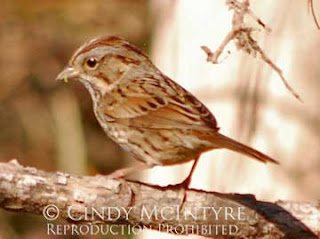Blue Jays, which we're all familiar with, are also favorites of mine because they're so beautiful and sassy. I've never seen them actually harass birds at the feeder, but their size and brazen swooping onto the feeder tends to intimidate the smaller birds into scattering. So misunderstood!
The Common Pauraque is my other new fave. This bird is in the nightjar family - a nocturnal bug-eater like the whip-poor-will with a tiny bill and huge maw for gathering lots of skeeters and such. It sleeps during the day, and at the Estero Llano Grande State Park they don't seem to mind parking themselves right beside the trail. Two of them were so well hidden in the dead leaves that even though the area was marked off and I knew they were there, it took a few minutes before I could actually tease their form out of the forest floor.
The exquisite patterns and earth tones of their feathers, and their supreme confidence in their invisibility, as well as just being darned cute, won my heart. I so wanted to pick them up and pet them.
The Buff-Bellied Hummingbird is also another new favorite. It is quite a bit larger than the ruby-throated hummer which is the only breeding hummingbird on the East Coast. The male is iridescent and this one kept up a steady chipping like that of a verdin. Evidently there was another hummer in the area it was trying to keep from "his" feeders.
Aside from the great birds, I didn't really care for South Texas. For one, it was too cluttered and populated. And they don't clean their roadsides and vacant lots. I've never seen a landscape as littered with white plastic shopping bags as I did in the Lower Rio Grande Valley. One town had vacant lots dotted with fluttering bags stuck on grass stalks as if they were purposely planted there. Plus I could only find a Public Radio station coming in weakly near Estero Llano, and that was from Corpus Christi. At best, three of four radio stations are entirely in Spanish. I know this is a haven for "winter Texans" but I much prefer the wide open spaces of Far West Texas and Big Bend. Anyway, more birds:
The Altamira Oriole is lured in by oranges placed in many of the park and refuge feeding stations. It is said orioles won't eat oranges unless they've been cut open - they either can't or won't penetrate the skin to get at the luscious fruit inside. Good thing, or the citrus farmers might have eliminated them long ago.
An Altamira and Audubon's Oriole, which is more yellow, have a dispute at the feeder. A hooded oriole also visited this prolific site, which was at Salineno. It is worth stopping at the World Birding Center in Roma, a little town just east, for info on how to get to this site, as well as some good books and t-shirts.
The land is owned by the Valley Land Fund and donations bring in seed and fruit that attract so many colorful birds it's as if they're living Christmas ornaments. The caretaker had to keep swooshing away the red-winged blackbirds that were eating her out of house and home, but they finally got the idea and segregated themselves in a far part of the yard near another feeder.
Audubon's Oriole closeup
Some birds at Bentsen-Rio Grande Valley State Park, which is known for attracting rarities (rare only in America, I should say.) As for overall quantity and variety of birds in general, I found it to be rather sparse.
Black-headed Grosbeak, female
This is a mutation of a white-winged dove - a chocolate color rather than buff
And a hybrid oriole - called by the locals as the "Smudgy Oriole"
Female red-winged blackbird sporting pink epaulets - females typically have no wing color.
Plain Chachalaca, a chicken-like bird that reminds me of the wild turkeys I have in my yard in Maine
I did see the black-vented oriole (from Mexico - rare here) but only have video of it. When I first arrived at this park, I went over to one of the four benches parked near the birdfeeders, where the Chachalacas were greedily feeding. A lady, whom I will call the Bird Nazi, informed me that people weren't allowed in that area because of the crowds of people that have been coming to see this bird. I looked at the lone guy standing behind me, pointed out the benches which were obviously made for sitting on, and the guy insisted that because this bird was "rare" that it would be intimidated by people close to it. So while I obediently stepped back to the "safe" area, little noisy golf carts, bicyclists, and pedestrians walked right by the sacred feeders. Evidently this "rare" bird is scared off only by people sitting quietly on benches.
I was so turned off by that attitude that I stalked off to another area where several birders awaited the hopeful arrival of the also-rare (north of the border, anyway) blue bunting and told them what happened. They were equally incredulous. That bird has been around for weeks and people were regularly a few yards away from it, apparently no harm being done to it. I can see why birders have gotten a bad name from non-birders. That was definitely a first for me.
Falcon State Park and Salineno:
The Great Kiskadee - a very large and stunning flycatcher
Couch's Kingbird
Harris's Hawk
Bobwhite male
Long-billed Thrasher (similar to the Brown Thrasher)
Olive Sparrow
Lincoln's Sparrow
Orange-crowned Warbler
Inca Dove
Common Ground Dove
White-tipped Dove
I will say that Texas has some of the best state parks I've ever seen, and even many of their roadside picnic areas are very pleasant places, with wildflowers and cactus blooms in spring.
And now some water birds from Estero Llano State Park
Fulvous Whistling Duck
Northern Shoveler
Ring-necked duck
Gadwall
Common Moorhen
Spotted Sandpiper in winter plumage
Least Sandpiper
Little Blue Heron
Least Grebe (they fluff up their whitish bottoms like cotton balls)
Gas went up 15 cents a gallon in the four days I was on the road. Every gas pump in Del Rio on Friday was $3.05. Don't tell me that's not price fixing! But while I was there I got groceries at HEB (great produce - what a luxury!), got a haircut for $17.95, bought some summer shirts marked way down at Fashion Bug, turned in my ink cartridges at Staples for a $20 credit, and drank gallons of Dr Pepper (which I try to keep out of the house) and ate Jack in the Box tacos and Dairy Queen Flame Kickers. (I know it's pathetic, but I'm a child of the fast food restaurants.)
Despite the Border Patrol checkpoints and their numerous white-and-green vehicles everywhere, it was a great birding trip, with a little crass consumerism thrown in, and I can't wait for my next foray of birding. Stay tuned!





































Wonderful pictures and commentary. BTW, gas is now $3.25 at HEB...
ReplyDeleteGreat pictures as usual Cindy. Enjoyed the commentary too.
ReplyDeleteCindy, Cindy,
ReplyDeleteYou are an amazing photographer! I sent your link on to my colleague, Bird Man Bob.
In the midst of freezing rain and snow, your little birdies were more than welcomed. Deb and I saw the first cedar waxwings of the season enjoying the crabapples in front of the Y this morning. A pretty decent sized flock. Bet they were wishing they'd found better weather. Great snow plowing season though. Eat some fast food for me.
ReplyDeleteChris